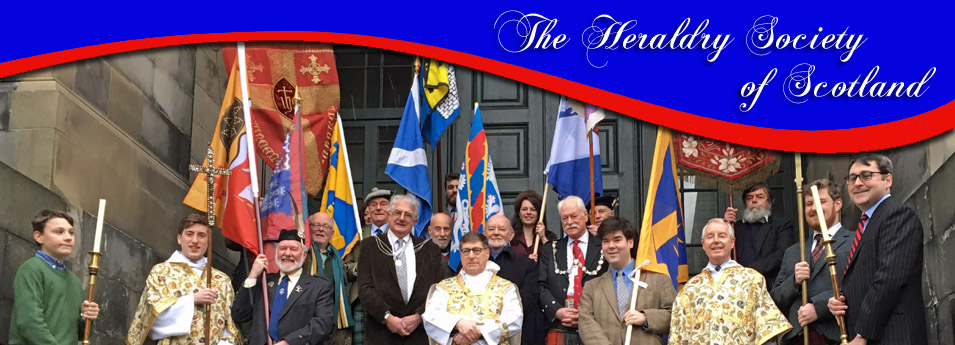|
|
| |
Scots Heraldry - The Heraldry
Society of Scotland |
. |
| |
|
|
| |
West Highland Heraldry -
The Meanings
| |
|
Let us now look
more closely at the users of West Highland heraldry -
The Macdonalds |
| |
|
The MacDougalls |
|
|
The senior line
descended of Somerled is that of the MacDougals of Dunollie,
formerly Lords of Lorne, who used the style "de Ergadia" - "of
Argyll". They are on record as using the galley on its own in
1296, between 1300 and 1307 and again in 1332. The Red Hand was
added in a seal of 1565. The Dunvegan Armorial of 1582 gives the
first appearance of the MacDougall Lion rampant, silver on blue
but this time with the addition of three silver mullets in chief -
a possible reference to Moray at the other end of the Great Glen
from Dunollie, the seat of Loam so many of whose descendents
appear again in the area around Inverness. |
|
|
The MacDougalls
originally buried their Chiefs at Ardchattan, built by Duncan
MacDougall around 1232, until the burial of an 18c Chief was held
up by a furious storm which prevented the funeral cortege crossing
Loch Etive. After several days, urgent action was imperative and
the mourners took him through the hills to Kilbride, south of
today's Oban where the MacDougall chiefs now have their mausoleum.
Here is to be found the coat of 1737 which has everything in it,
all four symbols plus a castle, and in 1785, the first appearance
of today's coat borne by the MacDougall Chiefs which quarters the
lion rampant with the galley. |
 |
|
Seals 1296, 1300-7. Balliol Roll
|
|
 |
|
Workman's Manuscript |
|
 |
|
The Dunvegan Armorial
|
|
|
 |
|
Tombstone Kilbride
|
|
 |
|
Tombstone Kilbride
|
|
 |
|
Lyon Office
|
|
|
|
The
Macdonalds |
|
|
|
The MacDonalds,
too, were early users of the galley down to the time of John, 1st
Lord of the Isles. Subsequent Lords were frequent users of seals
and seem to have altered their pattern with regularity. From the
considerable number on record, I start with seals of Donald, Lord
of the Isles who fought the Battle of Harlaw in 1411 over his
claim to the Earldom of Ross Several historians have commented on
the fact that he might have had ideas of a an even greater claim
and the addition of the Royal double tressure to the galley -as
well as the eagle displayed may well have reflected this; his
mother, after all, was the daughter of King Robert II. After his
defeat at Harlaw it may be significant that the double tressure is
dropped - for a time. Through his wife Lady Margaret Leslie he
claimed the earldom of Ross and this is reflected in the
consequent use of the three lions rampant of Ross. the Leslie
buckles on a bend and the Comyn garbs - this last referring to the
half-share in the earldom of Buchan also inherited through his
wife's great-uncle. |
|
|
|
Quite what the
hand and dagger in the seal of John, last Lord of the Isles of
1472 represents, I am not sure, although I do not think it is the
Red Hand of the O'Neills. |
|
|
|
In 1493 the
Lordship of the Isles was forfeited and the Clan Donald
fragmented. Thereafter it would appear that the use of the
quartered West Highland coat became prevalent if not universal
among the chiefs of the various branches although the first
instance of its use does predate 1493. |
|
|
 |
|
Keppoch
|
|
 |
|
Clanranald
|
|
 |
|
Lord of Kintyre
|
|
 |
|
Sleat
|
|
|
 |
|
'MacDonald Buie'
|
|
 |
|
Dunnyveg
|
|
 |
|
Earl of Antrim
|
|
 |
|
Sleat
|
|
|
|
|
As early as
1461 Celestine, Lord of Lochalsh, younger brother of John,
last Lord of the Isles had introduced the galley and the
single lion rampant into his coat while his son Alexander in
1492/3 adds the red hand thereby scoring three out of
four.This branch of the family, even before the forfeiture had
been showing signs of wanting to contest the leadership of the
great Clan Donald and it is not impossible that this was
reflected in their use of heraldry. |
|
|
 |
|
Celestine, Lord of Lochalsh
|
|
|
|
 |
|
Alexander of Lochalsh
|
|
|
|
|
|
|
|
|
|
© The Heraldry Society of
Scotland last Update
27 Oct 2021 |
|
